At the beginning of the 19th century, there were 13 dwellings along Bow Street. These dwellings included eight houses and five cottages. Of the eight houses, six were farms with land ranging from around seven acres to 43 acres.
George Cady (Caddy) of Rockland All Saints, owned one of the houses together with seven acres of land. Cady let this farm and land to Jonathan Stacy (also found as Stacey).
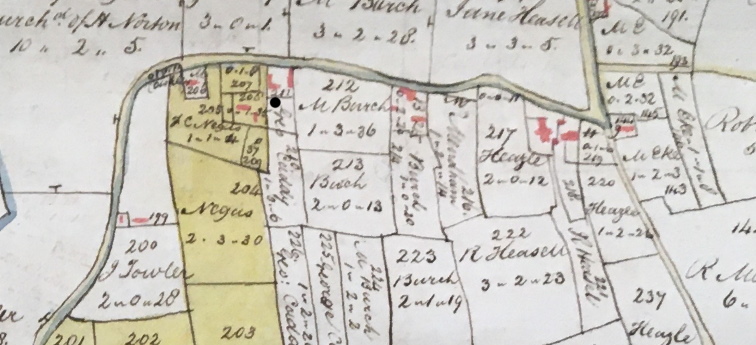
Extract from 1802 Map of Great Ellingham. Original held at Norfolk Record Office. Russell James Colman Plans. Cat. Ref. C/Ca 1/84. With kind permission of NRO
The black dot on the above extract from an 1802 map of Great Ellingham shows the position of the farm owned by George Cady and occupied by Jonthan Stacey.
Copyhold of Ellingham Hall
The Great Ellingham Inclosure Statement of Claims c.1799, reveals that George Cady owned one messuage (house with outbuildings and land) and five acres of land occupied by Jonathan Stacy. The messuage and three acres of land were copyhold of the Manor of Ellingham Hall. Cady also claimed various rights over the commons and waste lands for the benefit of his property.
As the house is copyhold (as opposed to freehold), the Manor Court Rolls (or Court Books) for the Manor of Ellingham Hall will provide the names of earlier owners of the house – or, at least the owners of the land on which the house was built.
Particulars & Valuation
A Particulars & Valuation of 1800 (which also relates to the inclosures), describes the following property and land (together comprising 7a 1r 29p – 7 acres, 1 rood and 29 perches) occupied by Jonathan Stacy and owned by George Caddy:
- No.210 Home Pightle 1a 0r 6p
- No.211 House Barn Stable Yard Garden & Orchard 0a 1r 34p
- No.225 Long Acre 1a 1r 0p
- No.226 Two Acres 1a 2r 28p
- Allotment upon Common 3a 0r 1p
The numbering used in the schedules to the Particulars & Valuation concur with the 1802 map of Great Ellingham. Accordingly, we can see exactly where Jonathan Stacy lived and the extent of the land he farmed.
The black dots on the following extract from the 1802 map indicate the property and land occupied by Jonathan Stacy in Bow Street.
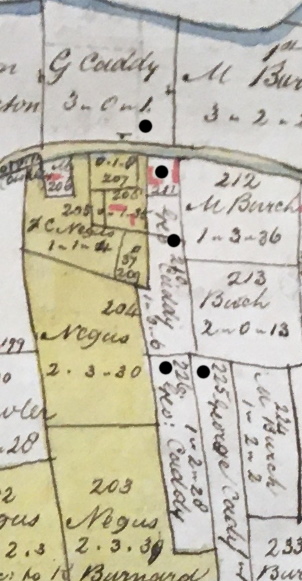
Extract from 1802 Map of Great Ellingham. Original held at Norfolk Record Office. Russell James Colman Plans. Cat. Ref. C/Ca 1/84. With kind permission of NRO
Occupier Jonathan Stacy
I do not know when Jonathan Stacy moved to Cady’s farm in Bow Street. However, he may have been living in Great Ellingham in 1787.
The Norfolk Chronicle of the 17th March, 1787, published a notice of a forthcoming auction which included a freehold messuage in Great Ellingham called ‘Jessups ‘which was occupied by Jonathan Stacy.
I found burials in the Great Ellingham Parish Registers for Jonathan Stacy aged 65 on 13th February, 1825, and a Mary Stacy aged 68 on the 6th January, 1829. I have assumed that Jonathan and Mary were a married couple.
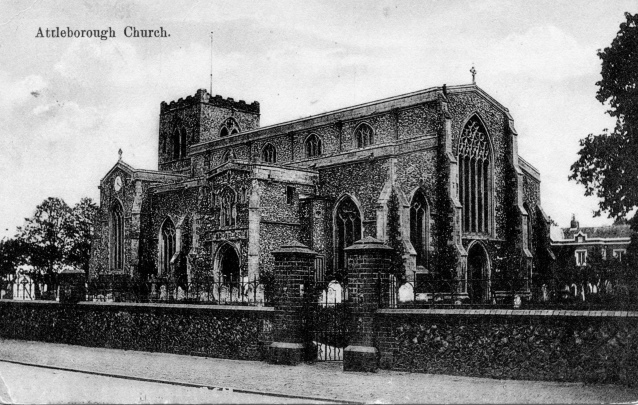
St Mary’s Church, Attleborough. Courtesy of BCV
Jonathan Stacy married Mary Osborne in St Mary’s Church, Attleborough on the 28th February, 1783. Assuming this is the Jonathan and Mary Stacy who died in Great Ellingham, then the couple were in Great Ellingham within a few years of their marriage.
However, it seems that Jonathan and Mary Stacy moved out of the farm in Bow Street before 1817.
Owners William Howes & James Howes
Occupier Francis Rivett
A Survey of Great Ellingham 1817-1819, reveals the same house and land in Bow Street as earlier owned by George Cady, as now owned by William Howes. However, the house and land was occupied by Francis Rivett.
By this time, the parcels of land numbered 225 and 226 in the Schedule to the Particulars & Valuation of 1800, are amalgamated and referred to as ‘Three Acres’ comprising 2a 3r 28p.
Although it is possible that Francis Rivett continued to occupy the farm until around 1841, James Howes owned the farm in succession to William Howes. I have not been able to establish what (if any) connection there is between William and James Howes, or whether James Howes purchased the farm or inherited it.
Occupier William Chaplin
The 1841 census shows both Francis Rivett and William Chaplin living in Bow Street.
75 year old Francis Rivett is described as a farmer and, apart from a 25 year old servant, Mary Rose, he is living alone.
Not far away is William Chaplin and his wife Jane and their children. Given that Francis Rivett’s occupation is a farmer and William Chaplin is a carpenter, I think perhaps it is more likely that Francis Rivett is still occupying the farm at this time.
Francis Rivett died in April 1848. In his will, Francis Rivett is described as a fowl merchant of Great Ellingham. A later occupier of the farm (James Fox) was a chicken dealer.
By the census of 1851, I am certain that 52 year old William Chaplin is in occupation of the farm. The census describes William Chaplin as a farmer of 7 acres – which concurs with the extent of the land being farmed by Jonathan Stacy some 50 years earlier.
However, I do not know whether William Chaplin also owned the farm. In addition, was the farm still copyhold of the Manor of Ellingham Hall, or, had it been enfranchised and was now freehold?
Chaplin Family
William Chaplin was born in Great Ellingham in 1799, and baptised in the Parish Church of Great Ellingham on the 26th May the same year. His parents were William and Mary Chaplin (née Browne).
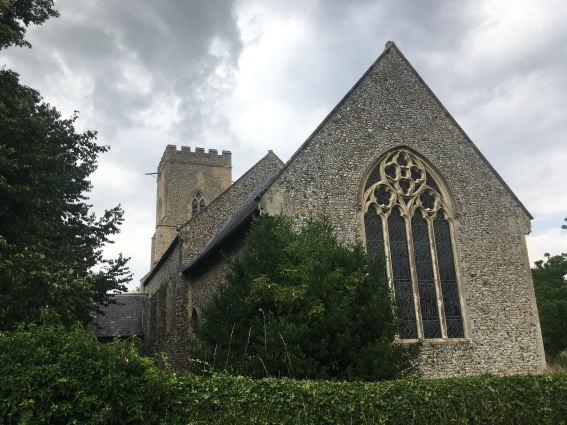
Church of All Saints, Snetterton
William Chaplin, a single man of Watton, married Jane Ann Barham in the Church of All Saints, Snetterton on the 5th May, 1819. The marriage was by a licence and not after the reading of banns. There are severals reasons why a couple would choose to obtain a licence rather than wait for banns to be read. Here, I believe there was some haste to tie the knot – Jane was heavily pregnant!
Just six weeks after the wedding, on the 29th June, 1819, Jane Chaplin gave birth to a son, William. I have no doubt that the child was named after his father, grandfather and, I believe, his great grandfather.
William Chaplen was baptised in the same Parish Church at Snetterton on the 4th July, 1819.
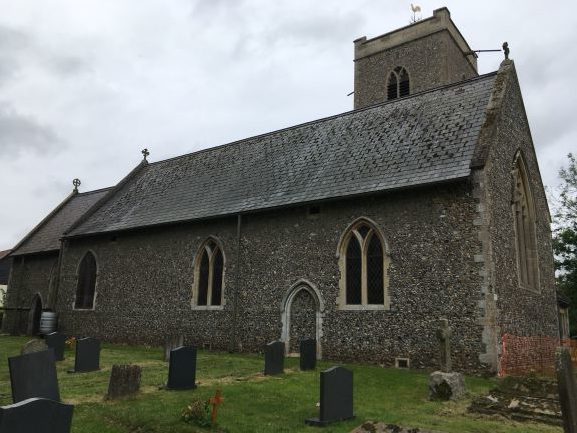
St Peter’s Church, Little Ellingham
In addition to William, William and Jane Chaplin had at least four more children. The family were living in Little Ellingham at the time of the baptism of their daugher Jane Anne in the Church of St Peter’s, Little Ellingham, on the 19th March 1826.
By 1841, the family were in Bow Street, Great Ellingham. The census of that year shows the family as 40 year old William Chaplin, his wife Jane aged 41, children William 20, Francis 15, Jane 15, Jemima 8 and Elizabeth 3. William and his son are both described as carpenters.
As mentioned, the family are living at the farm in Bow Street in 1851. Now aged 52, William Chaplin is described as a farmer of 7 acres. With William is his 51 year old wife Jane Ann and their 13 year old daughter Elizabeth. 15 year old Rocklands born Ezekiel Starke (described as an apprentice) is also with the household. Elizabeth Chaplin later married Ezekiel Starke in 1856.
William and Jane Chaplin continued to live in Bow Street for the remainder of their lives. However given that by 1861, William Chaplin was farming 21 acres, I believe that William Chaplin may have either acquired (or rented) more land to farm or may have moved to another property in Bow Street.
Jane Chaplin died aged 69 years at the beginning of 1870. She was buried in the churchyard of St James on the 7th January.
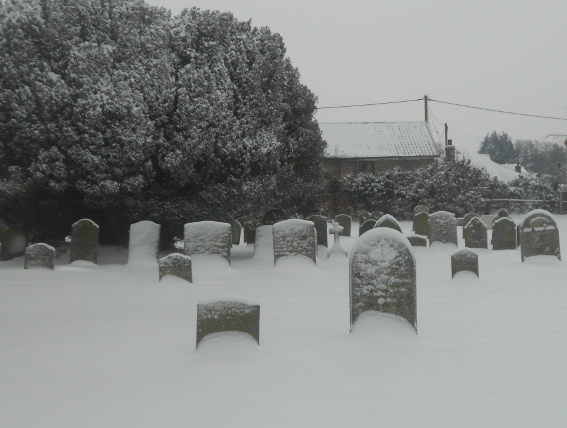
St James’s Churchyard, Great Ellingham. Photograph taken 5th February, 2012
William Chaplin died at the age of 75, and was buried in the same churchyard on the 22nd January, 1875.
What Happened to the Farm?
As to the farm of 7 acres which in 1800 was owned by George Cady and occupied by Jonathan Stacy, it was certainly a farm up to and including the tenure of William Chaplin.
The farmhouse and farm buildings which the Stacys, Rivetts and Chaplins occupied are most probably the same buildings which stand today, albeit that they may have been altered over the years.
Although I do not know the owners or occupiers of the farm following William Chaplin’s tenure, I feel sure that this is the very same farm which chicken dealer James Fox lived in by 1901.

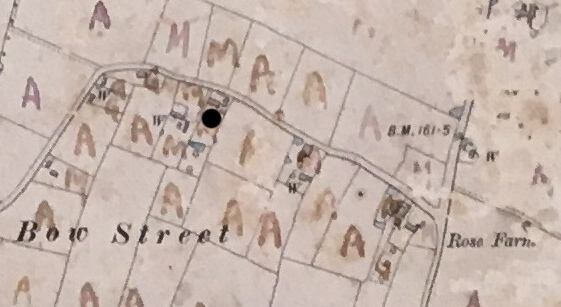
The black dots on the above extract from maps of 1802 and 1906, shows the farm which in 1800 was owned by George Cady and occupied by Jonathan Stacy.
Sources:
Great Ellingham Parish Registers. Norfolk Record Office PD 609. Also available at www.familysearch.org
1802 Russell James Colman Plans. Great Ellingham. Catalogue Ref. C/Ca 1/84.
1799-1842 F W Horner, Records of the Surveyors to Commissioners for Inclosure in Parishes in Norfolk and Suffolk. Great Ellingham (Act 1799). Norfolk Record Office. Catalogue Ref: NRO, BR 90/2
1800 Inclosure Commissioner’s Particulars and Valuation, Great Ellingham. Norfolk Record Office. Catalogue Ref: NRO, MC 2213/119
1799 Statement of Claims. Great Ellingham Inclosure. Norfolk Record Office. Catalogue Ref: MC 2213/118
Norfolk Chronicle 17th March, 1787
Attleborough Parish Registers. Archdeacon’s and Bishop’s Transcripts. Norfolk Record Office PD 438. Marriage of Jonathan Stacey & Mary Osborne 28 February 1783. Archdeacon’s Transcript viewed via www.ancestry.co.uk
Snetterton Parish Registers. Archdeacon’s and Bishop’s Transcripts. Norfolk Record Office. PD 21. Marriage of William Chaplin and Jane Ann Barham on 5 May 1819.Archdeacon’s Transcript viewed via www.ancestry.co.uk
Baptism 5 July 1819 William Chaplen viewed via Norfolk Baptism Project website http://tinstaafl.co.uk/nbp/
Little Ellingham Parish Registers. Norfolk Record Office. PD 568. Viewed via www.ancestry.co.uk
1841 census HO107/781/8
1851 census HO107/1823/116
1861 census RG9/1237/83
1871 census RG10/1841/81
1848 Will of Rivett, Francis, fowl merchant, of Great Ellingham. Norfolk Record Office. NCC will register Denny 481. Available on microfilm MF 494.